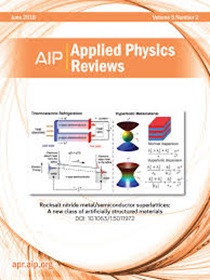银纳米粒子插层多酚修饰MXene膜的高效纳滤
IF 11.6
1区 物理与天体物理
Q1 PHYSICS, APPLIED
引用次数: 0
摘要
由二维纳米片逐层叠加而成的片层膜由于具有丰富的纳米通道,具有优异的纳米过滤功能,在纳滤领域具有广阔的应用前景。然而,这些层状膜的纳滤性能受到纳米通道的不规则性和纳米片的堆积缺陷的严重限制。为了解决这一问题,本研究提出了一种简单的方法,即使用茶多酚(TPs)修饰嵌入银纳米粒子(Ag@MXene)的层状MXene膜。经TP修饰后,MXene纳米片上存在的初始褶皱被压平,有效地减少了堆积缺陷,增加了纳米通道的规律性。因此,经过tp修饰的Ag@MXene (Ag@MXene-TP)膜的透水性显著提高,达到137.7 Lm−2 h−1·bar−1,是原始MXene膜透水性的3倍。重要的是,Ag@MXene-TP膜保持了较高的染料去除率,罗丹明B的去除率为95.85%,刚果红的去除率为97.30%。分子动力学模拟进一步阐明了水渗透性增强的潜在机制。研究发现,TPs在MXene表面的吸附通过屏蔽MXene纳米片与Ag纳米粒子之间的静电引力,阻止了MXene纳米片的聚集。此外,纳米通道的规整性增强也大大降低了水输送阻力。这种利用TPs对MXene纳米片进行预修饰的策略,为高性能纳滤膜构建规则性更好的MXene纳米通道提供了新的途径。本文章由计算机程序翻译,如有差异,请以英文原文为准。
Polyphenol-modified MXene membrane with Ag nanoparticles intercalation for high-performance nanofiltration
Lamellar membranes fabricated through the layer-by-layer stacking of two-dimensional nanosheets hold great promise in the field of nanofiltration (NF) owing to the existence of abundant nanochannels that function as excellent nanofilters. However, the NF performance of these lamellar membranes is severely limited by the irregularity of the nanochannels and the stacking defects of the nanosheets. To address this issue, a facile approach was proposed in this study, which involved the modification of lamellar MXene membranes intercalated with Ag nanoparticles (Ag@MXene) using tea polyphenols (TPs). Upon the TP modification, the initial wrinkles present in the MXene nanosheets were flattened, which effectively reduced the stacking defects and increased the regularity of the nanochannels. Consequently, the water permeability of the TP-modified Ag@MXene (Ag@MXene-TP) membrane significantly increased up to 137.7 Lm−2 h−1·bar−1, a value that was three times the permeability of the pristine MXene membrane. Importantly, the Ag@MXene-TP membrane maintained a high dye rejection rate, with values of 95.85% for Rhodamine B and 97.30% for Congo Red. Molecular dynamics simulations further elucidated the underlying mechanism for the water permeability enhancement. It was found that the adsorption of TPs on the MXene surface prevented the aggregation of MXene nanosheets by shielding the electrostatic attraction between the MXene nanosheets and the Ag nanoparticles. In addition, the enhanced regularity of the nanochannels was also found to cause largely reduced water transport resistance. This pre-modification strategy of MXene nanosheets with TPs provides a new way to build MXene-based nanochannels with improved regularity for high-performance NF membranes.
求助全文
通过发布文献求助,成功后即可免费获取论文全文。
去求助
来源期刊

Applied physics reviews
PHYSICS, APPLIED-
CiteScore
22.50
自引率
2.00%
发文量
113
审稿时长
2 months
期刊介绍:
Applied Physics Reviews (APR) is a journal featuring articles on critical topics in experimental or theoretical research in applied physics and applications of physics to other scientific and engineering branches. The publication includes two main types of articles:
Original Research: These articles report on high-quality, novel research studies that are of significant interest to the applied physics community.
Reviews: Review articles in APR can either be authoritative and comprehensive assessments of established areas of applied physics or short, timely reviews of recent advances in established fields or emerging areas of applied physics.
 求助内容:
求助内容: 应助结果提醒方式:
应助结果提醒方式:


